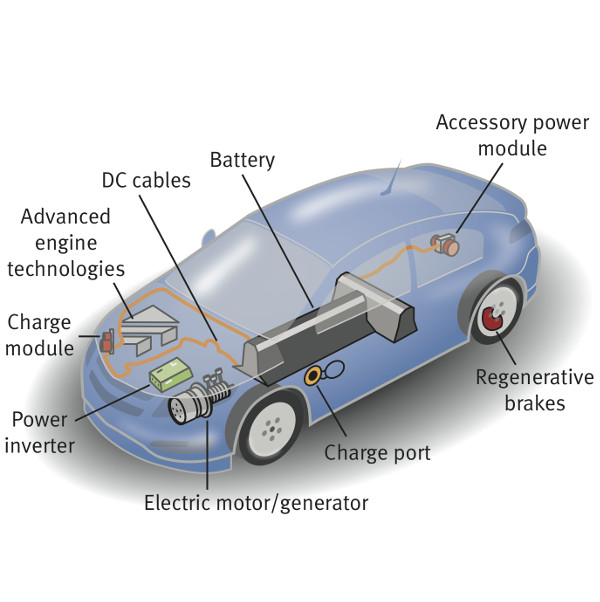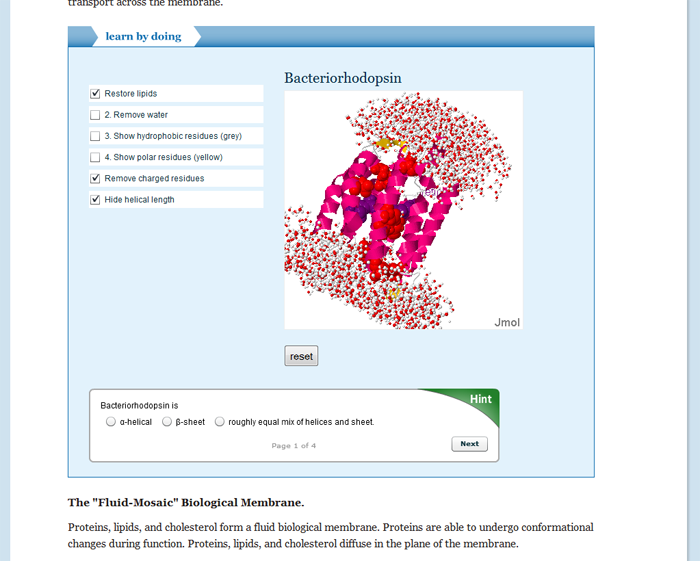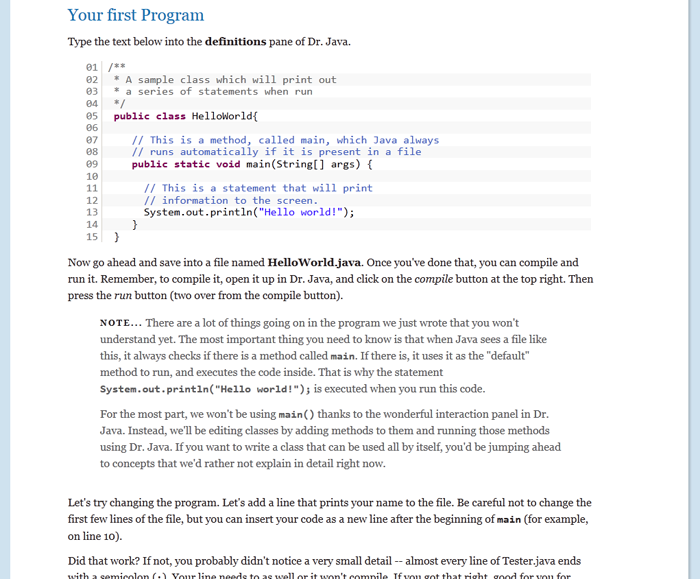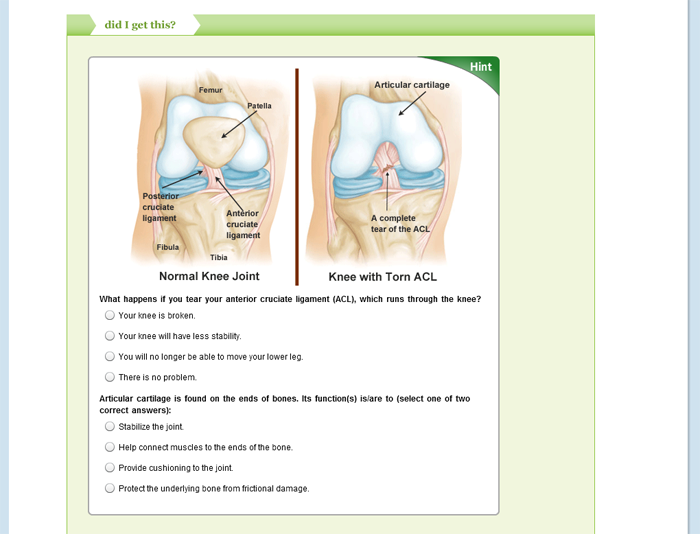Learn about electric vehicle development and maintenance. Electric Vehicle students are prepared for product development positions in the automotive, communications, solar, wind turbine, and smart grid industries and service positions in the automotive industry.
Learn about Open & Free OLI courses by visiting the “Open & Free features” tab below.
Electric Vehicle Technology — NSC STEM Pathways Open & Free
- Description
- What students will learn
- Learning objectives by OLI module
- Course outline
- Other course details
- System requirements
- Open & Free features
Description
The National STEM Consortium’s (NSC) Electric Vehicle Technology Pathway is a one-year, 30-credit hybrid course (mixture of online and face-to-face) consisting of 14 mini-courses. The entire Pathway consists of a set of materials a school or institution can customize for their program’s or students’ needs. Each mini-course includes:
- A downloadable Teaching Toolkit with the following documents:
- A course introduction (READ ME) that explains the course, including course structure, learning outcomes, prerequisites, and suggested texts.
- A suggested syllabus that you can customize to your college, department, course, and individual preferences.
- Suggested lesson plans with learning outcomes and assessments, lesson outline, teaching tips, and instructional resources.
- Supplemental materials as labeled.
- OLI online modules to help prepare students for face-to-face instruction, by providing mini-lessons and interactive drills that address common sticking points
NOT INCLUDED are the recommended textbooks. See the README First document in the Teaching Toolkit for each mini-course for a list of recommended texts.
Created through a collaboration with the OPEN Platform+ program, the National STEM Consortium academic certificate in Electric Vehicle Technology is built on a 30-semester-credit model and includes two tracks: (1) Electric Vehicle Development, and (2) Electric Vehicle Service. Graduates are prepared for product development positions in the automotive, communications, solar, wind turbine, and smart grid industries and service positions in the automotive industry.
NSC STEM Pathways
STEM Pathways are five certificate programs developed by the National STEM Consortium (NSC). NSC is a collaborative of ten colleges in nine states, funded by a U.S. Department of Labor grant to develop one-year, 30-credit certificate programs in five Science, Technology, Engineering, and Mathematics (STEM) fields: Composites Technology, Cyber Technology, Electric Vehicle Technology, Environmental Technology, and Mechatronics Technology. In collaboration with the OPENPlatform+ program, these have been implemented and made available on the OLI platform, with learning activities targeting specific areas of challenge, resources to support instructors and implementation guides for administrators.
The STEM Pathways use an innovative two-part STEM Bridge program to improve completion and success rates of students. This program embeds contextualized refresher instruction in mathematics, communication, and professionalism to eliminate traditional remedial courses and prepare students for success in demanding technical courses. The NSC STEM Readiness course enables students who are not fully college-ready in math to enroll and succeed in the technical curriculum, thus broadening the pool of potential students and opening STEM careers to a greater number of workers. The second element of the STEM Bridge is designed as a FAST TRACK program to support learners who require more intensive, up-front development of the basic skills required for access to the technically demanding educational pathways into STEM occupation. The STEM Foundations course provides elements of this FAST TRACK approach.
The NSC academic model is built on four research-based strategies that, when combined, yielded an average 69% on-time completion rate across its students nationwide.
First, NSC instruction is outcomes-driven, delivering learning outcomes mapped to industry standards. NSC member colleges formed regional advisory boards to respond to industry needs and employer requests. These materials include implementation guides with examples and recommendations from colleges whose regional economies support a diversity of industries, such as healthcare, construction, and the military.
Second, NSC programs are one-year, 30-semester-credit academic certificates. Certificates are a highly effective tool for workforce development, and are most effective when they are long enough to be rigorous yet short enough to be achievable. The certificate-level credential is a missing, but critical, on-ramp to career pathways for adult learners who often lack access to and awareness of high-demand careers in STEM fields. Graduates receive the greatest return on investment from certificates of one year or longer with a load of thirty-six semester credits or fewer.
Third, NSC programs use a built-for-completion structure including a program navigator, cohort structure, block scheduling, compressed timeline, enhanced student support services, and employer partnerships. Research has shown that it is the combination of strategies, rather than any single strategy, that boosts student success. Specifically, a growing body of evidence argues for “strategy intervention at a more comprehensive and integrated level that aims at simultaneous change focusing around whole program design and delivery – improving the coherency of instruction and educationally relevant services that students need as they move through their program of study.”
Last, NSC programs embed contextualized refresher instruction in mathematics, communication, and professionalism to eliminate traditional remedial courses and prepare students for success in demanding technical courses. The NSC STEM Readiness course enables students who are not fully college-ready in math to enroll and succeed in the technical curriculum, thus broadening the pool of potential students and opening STEM careers to a greater number of workers.
Colleges aiming for systemic change in their student completion and achievement levels are strongly advised to adopt the entire NSC academic model. However, NSC programs are flexible by design, allowing institutions to customize implementation to their regional economy and local conditions. For example, a college might choose to pursue implementation in stages.
STEM Pathway Programs
- Composites Technology
- Cyber Technology
- Electric Vehicle Technology
- Environmental Technology
- Mechatronics Technology
STEM Bridge Courses
What students will learn
The NSC Electric Vehicle Technology certificate program has learning outcomes in the categories of Vehicle Systems, Safety, High Voltage Systems, Battery Systems, Control Systems, Electronic Systems, Thermal Systems, System Integration, Engine Systems, Tool Usage, and Technical Math. These outcomes are broad themes of the program, achieved in one or more of its courses:
- Diagnose, repair, and test HEV, PHEV, BEV vehicles and subsystems.
- Safely store, handle, and dispose of high voltage battery systems.
- Diagnose, repair, and test high voltage battery systems.
- Diagnose, repair, and test HEV, PHEV, BEV battery controls.
- Use software for HEV, PHEV, BEV control systems (e.g., MatLab, Simulink, LabVIEW, and CANalyzer).
- Diagnose, repair, and test DC/DC converters.
- Diagnose, repair, and test vehicle charging interface/infrastructure.
- Diagnose, repair, and test regenerative braking.
- Diagnose, repair, and test power electronic circuitry for electric drive systems.
- Diagnose, repair, and test motor control electronic hardware.
- Diagnose, repair, and test thermal systems management and control.
- Integrate automotive systems, include mechanic certification and testing requirements.
- Diagnose, repair, and test high voltage electric distribution systems.
- Diagnose, repair, and install engines.
- Diagnose, repair, and test cylinder heads.
- Test and diagnose engine performance.
- Diagnose, test, and repair electronic systems.
- Use tools in automotive and electronic learning environments.
- Use technical math to solve for unknown values.
Learning objectives by OLI module
Pathway 1: Electric Vehicle Technology
- Course 1: Advanced Energy Storage
- Analyze how the ordering of elements in the periodic table relates to valence electrons, chemical bonding, and stoichiometry in chemical reactions.
- Course 2: Automotive Systems
- Check sizes and pitch on both American standard and metric threads.
- Read an outside metric micrometer in 0.01 mm increments.
- Course 3: Electric and Hybrid Vehicle Technology 1
- Identify Hybrid Electric Vehicle (HEV) components and their function.
- Identify safety hazards of, and safe work practices for, electric and hybrid electric vehicle components.
- Course 4: Electric and Hybrid Vehicle Technology 2
- Describe the function of an inverter in electric and hybrid vehicles.
- Describe the operation of CVT in electric and hybrid vehicles.
- Course 5: Electric Vehicle Data Acquisition, Sensors and Control Systems
- Analyze the variables of distance, speed, and acceleration as a function of power, energy, and time
- Determine the value, product, and result of Boolean operators.
- Interconvert numbers between the binary, decimal, and hexadecimal number systems.
- Course 6: Electronic Technology 1
- Apply Ohm’s Law to electronic technology
- Apply the Maximum Power Transfer Theorem to DC circuits.
- Course 7: Electronic Technology 2
- Apply Ohm’s Law to AC circuits.
- Mathematically convert time and voltage values of a sine wave into their other mathematical forms.
- Course 8: Engine Fundamentals
- Describe the fabrication and function of engine blocks.
- Identify systems found in an Internal Combustion Engine (ICE) and their function.
- Course 9: Engine Performance 1
- Describe fuel pressure regulator function.
- Describe how an automotive ignition coil generates high voltage from a 12-volt source.
- Course 10: Introduction to Electric Vehicle Propulsion Systems
- Classify hybrid electric vehicle power flow.
- Identify the basic components of a planetary gear set and explain its operation as it relates to hybrid propulsion power interface.
- Course 11: LabVIEW Basics 1
- Apply common debugging methods to discover program errors in LabVIEW software.
- Use array tools in LabVIEW functions palettes.
- Course 12: Motors and Controls for Electric Vehicles and Industrial Applications
- Convert between English and metric units.
- Explain the relationship of an electromagnetic field.
- Course 13: Principles of Alternative/Renewable Energies
- Identify internal combustion engine components.
- Identify the components found in a hydrogen fuel cell and describe their function.
- Course 14: Technical Math – RCL Analysis
- Calculate all the electrical unknowns of a DC Parallel Circuit
- Calculate all the electrical unknowns of a DC Series Circuit
Course outline
PATHWAY 1: Electric Vehicle Technology
Course 1: Advanced Energy Storage
Course 2: Automotive Systems
Course 3: Electric and Hybrid Vehicle Technology 1
Course 4: Electric and Hybrid Vehicle Technology 2
Course 5: Electric Vehicle Data Acquisition, Sensors and Control Systems
Course 6: Electronic Technology 1
Course 7: Electronic Technology 2
Course 8: Engine Fundamentals
Course 9: Engine Performance 1
Course 10: Introduction to Electric Vehicle Propulsion Systems
Course 11: LabVIEW Basics 1
Course 12: Motors and Controls for Electric Vehicles and Industrial Applications
Course 13: Principles of Alternative/Renewable Energies
Course 14: Technical Math – RCL Analysis
Other course details
System requirements
OLI system requirements, regardless of course:
- internet access
- an operating system that supports the latest browser update
- the latest browser update (Chrome recommended; Firefox, Safari supported; Edge and Internet Explorer are supported but not recommended)
- pop-ups enabled
- cookies enabled
Some courses include exercises with exceptions to these requirements, such as technology that cannot be used on mobile devices.
This course’s system requirements:
- none listed (subject to change)
Open & Free features
Open & Free Courses
- Open & Free OLI courses enable independent learners to study a subject on their own terms, at their leisure. Courses are:
- Self-guided.
- Self-paced.
- Self-supported.
- Open & Free courses include only the learning materials:
- No teacher.
- No tests.
- No college credit.
- No certificate of completion.
- *If your teacher gave you a Course Key, do not use an Open & Free course because your teacher will never see your work.






